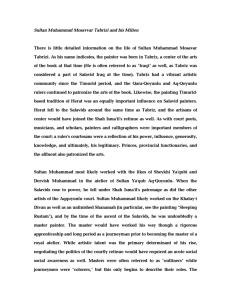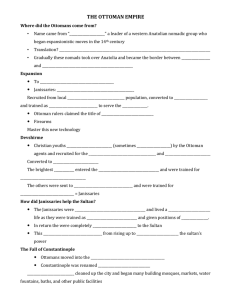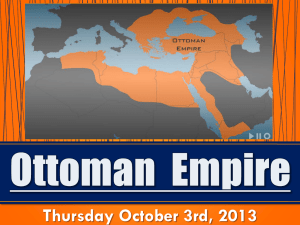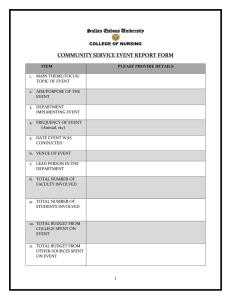AL FATEH ASSIGNMENT WRITTEN EDITED
advertisement
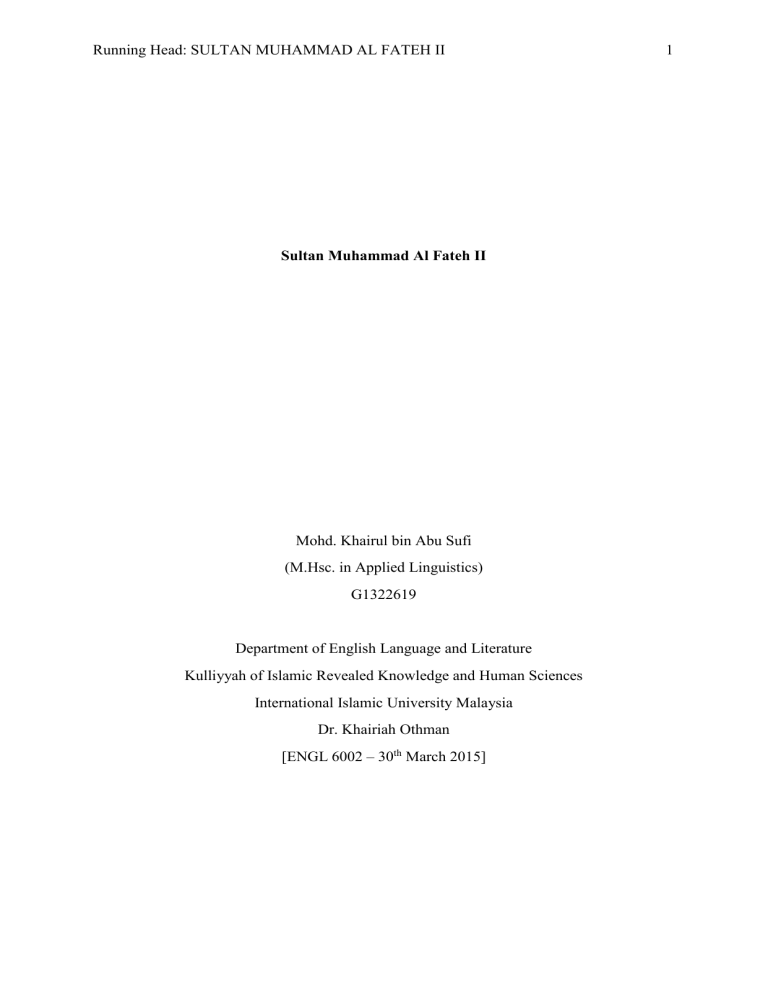
Running Head: SULTAN MUHAMMAD AL FATEH II Sultan Muhammad Al Fateh II Mohd. Khairul bin Abu Sufi (M.Hsc. in Applied Linguistics) G1322619 Department of English Language and Literature Kulliyyah of Islamic Revealed Knowledge and Human Sciences International Islamic University Malaysia Dr. Khairiah Othman [ENGL 6002 – 30th March 2015] 1 2 SULTAN MUHAMMAD AL FATEH II Sultan Muhammad Al Fateh II Constantinople is a very unique city in Europe as it is located in a very strategic geographic location, between two major continents, which is Asia and Europe (Nicolle & Haldan, 2007). Its geographical characteristic was further described by Nicolle and Haldan as “bordered with the Black Sea. From the East side, it was bordered with Syria and the Mediterranean Sea whereas at the West, it was near Bulgaria, Greece and Aegean Sea” (2007). It also played a very important role as a connector between Asia and Europe. This city was seen as the “Capital of the World” because of its prime trading position in the centre of the medieval world. According to Aras Demir (2014), Napoleon had once quoted as saying, “If the Earth were a single state, Constantinople would be its capital” (p. 35). From an Islamic perspective, the privileges of this great city had been revealed since the time of Prophet Muhammad ﷺas he had predicted that this city will eventually fall into the hand of the Muslims. As narrated by Abdul Latip Talib (2008), while digging trenches during the Battle of the Trench (Khandaq War), the Prophet’s shovel hit a rock and it sparked. He spontaneously shouted Takbeer three times. The Companions asked, “What has happened, O Messenger of Allah?” He replied, “I have seen some sparks. After the first spark, I saw the shadow of the White Palace in the state of Yemen in the air. After the second spark, I saw the shadow of Kisra Castle in the Land of Persia and after the third spark, I saw the king’s palace in Constantinople” (p.4). 3 SULTAN MUHAMMAD AL FATEH II In another hadith, as cited by Abdul Latip Talib (2008), Rasulullah ﷺsaid, “Verily, Constantinople shall be conquered. Its commander shall be the best commander ever, and his army shall be the best army ever”. The burning desire to be this “wonderful army” motivated many Muslims right from the time of the Sahaba in attempt to conquer Constantinople (Mustafa Kamal, 2011). Hence, many Muslims have tried to conquer Constantinople for over 800 years, through 10 attempts. Among them were ‘Uthman bin ‘Affan, Mu’awiyah bin Abu Sufyan, Abu Ayyub al-Ansari which he passed away as a martyr and buried there, Sulayman bin Abd al-Malik, Harun al-Rashid, and many Muslim commanders from the time of the Umayyad Empire, ‘Abbasid Empire and also the ‘Uthmaniyyah Empire. Eventually, this great city befell to the Muslim under the command of Sultan Muhammad Al Fateh II from the ‘Uthmaniyyah Empire on 29th May 1453M (Abdul Latip Talib, 2008). Politically, the Ottoman Caliphate territories lay partially in Asia and the rest of Europe. The geographical position of the Ottoman Empire which was surrounded by Christian kingdoms made it exposed to threats of the Crusader armies which persistently looked for opportunities to attack and destroy the Islamic army. Biography of Sultan Muhammad Al Fateh II Abdul Latip Talib (2008) narrated the biography of Sultan Muhammad Al Fateh II in detail. According to him, Sultan Muhammad Al Fateh II was born in Edirne, the then-capital city of the Ottoman state, on March 30, 1432. His father was Sultan Murad II and his mother Valide Sultana Hüma Khatun. When Sultan Muhammad Al Fateh II was 11 years old he was sent to Amasya to govern and thus gain experience, as per the custom of Ottoman rulers before his time and was appointed as governor with the assistance of two ministers, Zaqhanos and Shaykh Aaq Shemsuddin. They were responsible in guiding him and the desire to conquer Constantinople and when he was ready, Sultan Murad II abdicated the throne to his 4 SULTAN MUHAMMAD AL FATEH II 12-year-old son Sultan Muhammad Al Fateh II (Abdul Latip Talib, 2008). As soon as Sultan Muhammad Al Fateh II took helm of the Islamic Caliphate in 1451, he also inherited his father’s enemies who ruled in nearby territories (Ezad Azraai Jamsari, Ammalina Dalillah Mohd Isa & Mohamad Zulfazdlee Abul Hassan Ashari, 2014). In the conquest of Constantinople, Murphey (as cited by Ezad Azraai Jamsari, Ammalina Dalillah Mohd Isa & Mohamad Zulfazdlee Abul Hassan Ashari, 2014) affirmed that Sultan Muhammad Al Fateh II “..was after all a very successful commander and clearly took pride in his achievements in the military sphere and it is this pride in his record of military success that provides the clue to how we should interpret the pattern and underlying purpose of his various military undertakings” (p. 2158). Conquest of Constantinople When Sultan Muhammad Al Fateh II ascended the throne in 1451 he devoted himself to the preparations for the taking of Constantinople. Reference is made to the prospective conquest of Constantinople in a hadith attributed to a saying of the Prophet Muhammad ﷺ "Verily you shall conquer Constantinople. What a wonderful leader will he be, and what a wonderful army will that army be!” (theottomans.org). In preparation for war, researchers have deliberated that a fortress called Anadolu Hisari was built on the Asiatic side while on the European side, an even stronger fortress called Rumeli Hisari was erected, and thus having complete control of the strait. This fortress was built “to cut the throat of the Bosporus, that is, to block the pro-Byzantine ships, mainly under the Venetian or Genovese flag, by cannon bombardment both from the European and Asian sides” (Ozguven, 2014, p. 741). Another important function this fortress holds lies in the fact that it was used as a base station for the Muslim army and at the same time provide “logistical sites for uninterrupted war supplies” (Ezad Azraai Jamsari, Ammalina Dalillah 5 SULTAN MUHAMMAD AL FATEH II Mohd Isa & Mohamad Zulfazdlee Abul Hassan Ashari, 2014, p. 2160). Having completed his fortresses, Sultan Muhammad Al Fateh II, as explained by Ezad Azraai Jamsari, Ammalina Dalillah Mohd Isa & Mohamad Zulfazdlee Abul Hassan Ashari, proceeded to levy a toll on ships passing within reach of their cannon which was used to fund the war. In addition to that, he also increased the ufti from states which were under the Ottoman protection which successfully resulted to an increase of the state treasury (2014). In 1453, Sultan Muhammad Al Fateh II’s siege of Constantinople commenced in early April (Halil Inalcik, 1960). It was further explained that the city was surrounded by sea and land and Sultan Muhammad Al Fateh’s fleet of ships, at the entrance of the Bosporus was stretched from shore to shore in the form of a crescent, to intercept or repel any form assistance from the sea. Constantine (King of Byzantium), on the other hand ensured that the harbour of the Golden Horn was blocked by a boom chain and defended by twenty-eight warships (Abdul Latip Talib, 2008). It was further explained that after the first attack upon Constantinople, Sultan Muhammad Al Fateh II sent his messenger to the king of Byzantium asking him to hand over the city giving him a full guarantee of safety for its residents, their wealth, their lives, their beliefs and their honour. The refusal of the king to do this and his declaration of war against the Muslims led to the bombardment of the city resulting in the demolishing of some of the outer walls, without reaching the inner walls (Ozguven, 2014). When Constantine realized the seriousness of the situation, he wrote to the Pope and was assisted with five large ships filled with weapons, provisions, and soldiers, leading to the increase in morale of the defenders. Their joy did not last for long however, for the next morning, they were surprised with the presence of eighty ships inside their gulf which they had blocked with heavy chains and fortified with a large force. Sultan Muhammad Al Fateh II through his foresight brought the ships over land by paving a path for them of six miles of large tree branches which he had 6 SULTAN MUHAMMAD AL FATEH II embalmed with grease and animal blood so that the giant ships can slide over them with their tens of thousands of soldiers, until they were brought to the gulf waters behind the enemy defences (Abdul Latip Talib, 2008). This had been described as “a bold decision which was extraordinary, unconventional and unthinkable at that time” (Ezad Azraai Jamsari, Ammalina Dalillah Mohd Isa & Mohamad Zulfazdlee Abul Hassan Ashari, 2014, p. 2162). The siege of Constantinople lasted for fifty-four days (Abdul Latip Talib, 2008). The Byzantines also stretched their troops over a longer portion of the walls. With the new morn, Sultan Muhammad Al Fateh II ordered the setting up of his secret weapon which he had invented himself, which is giant mobile tower, higher than the walls of the city accommodating hundreds of soldiers. Further explained by Abdul Latip Talib, such war strategy struck fear amongst the Byzantines leading them to believe that the Muslims were using demons in their battles (2008) and when the Muslims broke the middle walls, the resistance of the city began to weaken leaving the Byzantines in fear leading them to spend their nights in their churches praying to their Lord to save Constantinople from the Muslims. Sultan Muhammad Al Fateh II also motivated his armies reminding them of the hadith of the messenger ﷺand praying for victory from Allah before they began their general attack. Ozguven (2014) explained that the actual destruction of the Byzantine city walls was achieved by the large, bronze shahi type of cannons, which were circa five meters long, weighed nineteen tonnes and forced a stone projectile weighing 500kg. These cannons, according to Ezad Azraai Jamsari, Ammalina Dalillah Mohd Isa & Mohamad Zulfazdlee Abul Hassan Ashari (2014) had not been owned by any other country and was cleverly engineered by a Hungarian, whom Sultan Muhammad Al Fateh II rescued from a prison in Constantinople (Abdul Latip Talib, 2008). The cannons were described as being powerful and massive in size and were capable of tearing down the wall of the fortress surrounding Constantinople. 7 SULTAN MUHAMMAD AL FATEH II During the attack by the Muslims, some mujahedeen were able to enter the city and the first to enter it was the Mujahid Hasan Ulu Badi with thirty of his companion, however, the arrows rained on them from every side, and they were all martyred (Abdul Latip Talib, 2008). Having witnessed this, Sultan Muhammad Al Fateh II stood and spoke to his remaining soldiers citing examples from the messenger of Allah ﷺduring the battle of Uhud (Bereke, 2014). Muhammad El-Halaby (1996) explained that on 29th May, a general assault was delivered onto the city and in a time frame of over a month later, Constantinople, which stood stubbornly in front of the Muslims for eight centuries, fell to the hands of Muslims ending the tyranny of the Byzantine government thus opening the doors of Europe for the call of Islam. Sultan Muhammad Al Fateh II allowed the return of Greeks who had left the city before the siege, after the conquest. They paid ransom and were granted immunity from taxation for a certain time. After this conquest, Sultan Muhammad Al Fateh II moved the Ottoman capital from Adrianople to Constantinople (Abdul Latip Talib, 2008). Administrative actions Sultan Muhammad Al Fateh II amalgamated the old Byzantine administration into the Ottoman state. He first introduced the word Politics into Arabic "Siyasah" from a book he published and claimed to be the collection of Politics doctrines of the Byzantine Caesars before him. He gathered Italian artists, humanists and Greek scholars at his court, kept the Byzantine Church functioning, ordered the patriarch to translate the Christian faith into Turkish (Raby, 2009). It was further described by Raby that Sultan Muhammad Al Fateh II also tried to get Muslim scientists and artists to his court in Constantinople, started a University, built mosques, waterways, and the Topkapi Palace (2009). 8 SULTAN MUHAMMAD AL FATEH II Sultan Muhammad Al Fateh II's reign was also well-known for the religious tolerance with which he treated his subjects, especially among the conquered Christians, which was very unusual for Europe in the middle Ages. Within the conquered city, Sultan Muhammad Al Fateh II established an autonomous religious community, and he appointed the former Patriarch as essentially governor of the city (Abdul Latip Talib, 2008). This method allowed for an indirect rule of the Christian Byzantines and allowed the occupants to feel relatively autonomous even as Sultan Muhammad Al Fateh II began the Turkish remodelling of the city, eventually turning it into the Turkish capital, which it remained until the 1920s (Halil Inalcik, 1960). Legacy According to Abdul Latip Talib (2008), Sultan Muhammad Al Fateh II spoke seven languages; Turkish, Greek, Hebrew, Arabic, Persian and Latin, when he was 21 years old, the age at which he conquered Constantinople. It was further reflected that after the fall of Constantinople, he founded many universities and colleges in the city, some of which are still active. Sultan Muhammad Al Fateh II is was also recognized as the first Sultan to codify criminal and constitutional law. This was further supported by Ezad Azraai Jamsari, Ammalina Dalillah Mohd Isa & Mohamad Zulfazdlee Abul Hassan Ashari (2014) whom discussed the matter: “Sultan Muhammad Al Fateh II also took a holistic approach by “consolidating political stability, expanding territorial control specifically over the surrounding regions of Constantinople and jihad expedition into the targeted strategic positions, similar to the measures taken by previous Muslim powers including the Abbasids in Baghdad, the Nasrids in al-Andalus and the Marinids in al-Maghrib” (p. 2162). 9 SULTAN MUHAMMAD AL FATEH II Death On May 3, 1481, at the age of 49, Sultan Muhammad Al Fateh II passed away to which certain expeditions were left unfinished (Abdul Latip Talib, 2008). Abdul Latip Talib further explained that his personal physician, Jacob Pasha (a Jewish revert) was suspected of administering poison to Sultan Muhammad Al Fateh II over a period of time, and was later prosecuted. The tomb of master of two seas and two continents “Sultan Muhammad Al Fateh II” is located at Fatih Mosque in Istanbul. Conclusion Sultan Muhammad Al Fateh II had proven to the world that he was indeed the best leader and his army was the best army as prophesised by Prophet Muhammad ﷺ800 years before Constantinople went to the hands of Muslims. His determination to take over Constantinople was his utmost priority and in fact, his besiege of Constantinople left an impact to the Islamic civilization. To illustrate, after the battle between the Turks and the Romans – to which the Muslims won indiscriminately, he was non-discriminatory and was just to the people there. For instance, he appointed Patrick (Abdul Latip Talib, 2008) as the bishop of the Catholics. He also gave the freedom to practice their religion anywhere with the exception of the Saint Sophia Church which was later transformed into the now Ayasofya Mosque. His actions had proven that Islam does not discriminate other religions and indeed is fair to all. Without a doubt, Sultan Muhammad Al Fateh II was indeed a great strategist during the Ottoman period displaying a true heroic personality and spirit. 10 SULTAN MUHAMMAD AL FATEH II References 1453 The Conquest. (n.d.). Retrieved February 27, 2015, from http://www.theottomans.org/english/campaigns_army/1453-the-conquest.asp Abdul Latip Talib. (2008). Sultan Muhammad Al-Fateh Penakluk Konstantinopel. Batu Caves, Selangor Darul Ehsan: PTS Litera Utama Sdn. Bhd. Aras Demir. (2014). Sidetracks - En Route to the Statue of Liberty. Victoria, BC: Friesen Press. Bereke. (2014, December). The Life of Sultan Muhammad Al Fatih [Video file]. Retrieved from http://www.berekatube.com/watch.php?vid=f81d70c5d Chambers, Richard. 'Turkey Travel Guide'. Turizm.net. N.p., 2015. Web. 23 Feb. 2015. Inalcik, H. (1960). Mehmed the Conqueror (1432-1481) and His Time. Speculum, 35(3), 408427. Retrieved March 13, 2015, from http://links.jstor.org Jamsari, E., Mohd Isa, A., & Abu Hassan Ashari, M. (2014). Sultan Muhammad al-Fatih: Ottoman's Great Strategic Planner. Middle-East Journal of Scientific Research, 20(12). Retrieved February 26, 2015. Muhammad El-Halaby. (1996, July). The liberation of Constantinople. Nida’ul Islam. Retrieved from http://pages.uoregon.edu/sshoemak/325/texts/cple1.htm Mustafa Kamal. (2011). The Conqueror of Hearts In the Land of Sultan Muhammad AlFateh. Maktabul Faqir. 11 SULTAN MUHAMMAD AL FATEH II Nicolle, D., & Haldon, J. (2007). The fall of Constantinople: The Ottoman conquest of Byzantium (pp. 14-20). Oxford: Osprey Publication. Ozguven, H. (2014). Early Modern Military Architecture in the Ottoman Empire. Nexus Network Journal, 16, 737-749. Retrieved February 26, 2015. Raby, J. (1982). A Sultan of Paradox: Mehmed the Conqueror as a Patron of the Arts. Oxford Art Journal, 5(1), 3-8.
